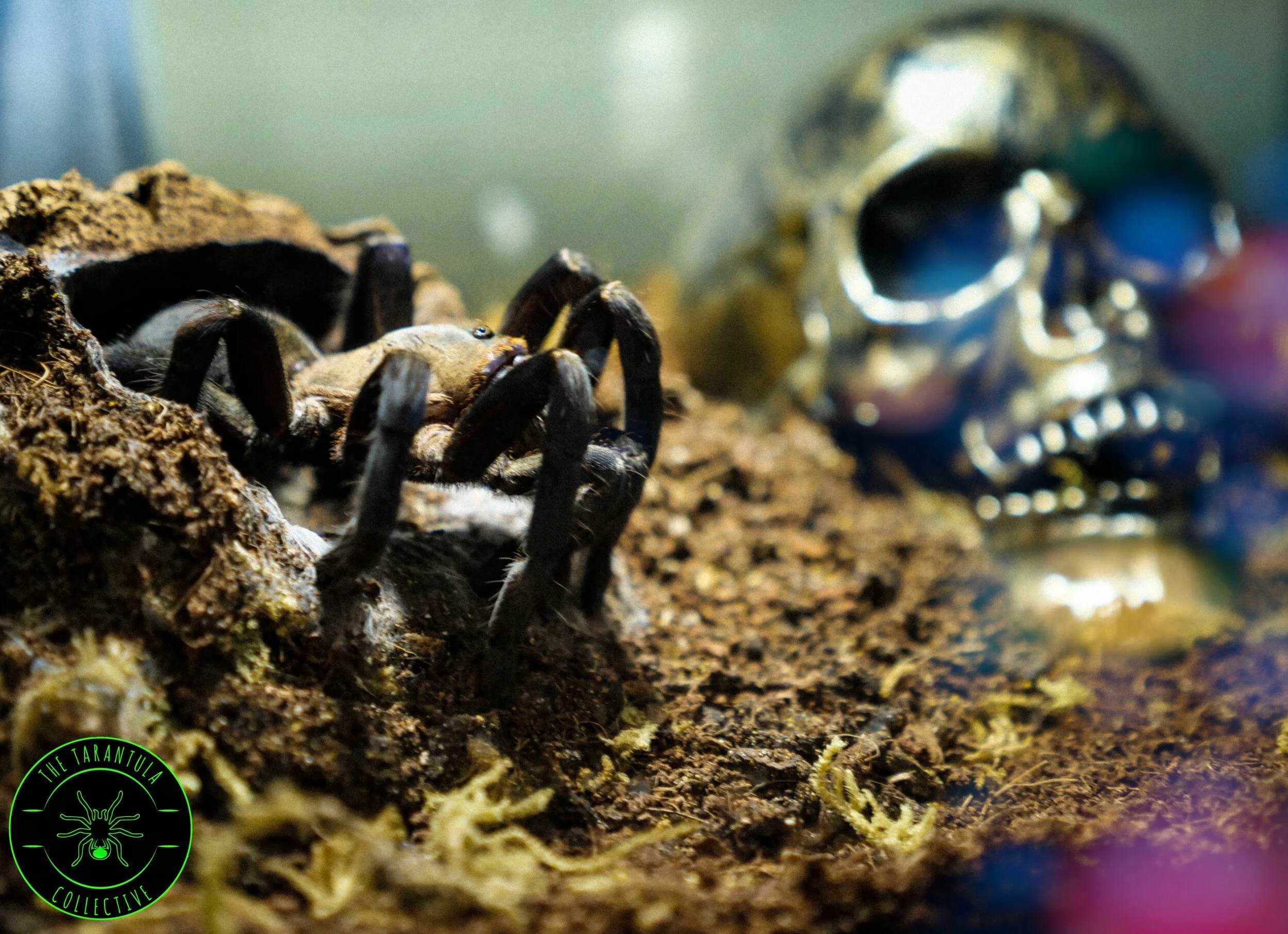Cobalt Blue Tarantula
Cyriopagopus lividus
(formerly Haploplema lividium)
Care Sheet
Cobalt Blue Tarantula Care
Cyriopagopus lividus Care Guide
The Cobalt Blue Tarantula
Revision Date: March 2025
Introduction
Today we’re focusing on the captivating Cyriopagopus lividus, commonly known as the Cobalt Blue Tarantula. Formerly known as Haploplema lividium, this striking species is an obligate burrower (fossorial) native to Southeast Asia, including Myanmar, Thailand, Laos, Cambodia, and Vietnam. Its vivid blue coloration makes it one of the most sought-after tarantulas, but its defensive nature and medically significant venom mean it is best suited for advanced keepers who can provide a secure and well-managed environment.
Quick Species Snapshot
Scientific Name: Cyriopagopus lividus (formerly Haploplema lividium)
Common Name: Cobalt Blue Tarantula
Type: Terrestrial, Fossorial (Obligate Burrower)
Native Range: Myanmar, Thailand, Laos, Cambodia, Vietnam
Body Length: Approximately 3.5” (9 cm)
Diagonal Leg Span (DLS): About 5” (13 cm)
Growth Rate: Medium
Life Expectancy: Females 15-18 years; Males 5-6 years
Experience Level: Advanced
What Makes C. lividus So Special?
The Cobalt Blue Tarantula is celebrated for its vivid, almost electric blue coloration, a true visual marvel. However, this beauty comes with a bold attitude. When threatened, it may perform rapid ground slapping and can bite if it perceives a serious threat. Its defensive behavior, combined with medically significant venom, makes handling a task strictly for those with advanced experience. Additionally, sexual dimorphism is pronounced: males are leggier and lighter in hue, while females are darker and more robust.
A Species at Risk
Cyriopagopus lividus demands a carefully controlled environment due to its specific moisture requirements and potent defensive responses. Although not currently listed as endangered, improper care can exacerbate stress and lead to health issues. Advanced keepers must be vigilant to maintain optimal conditions, particularly because this species’ venom can cause severe systemic reactions in sensitive individuals.
Taxonomy, Etymology & Natural Environment
Cyriopagopus lividus, commonly known as the Cobalt Blue Tarantula, is a striking Old World species within the Ornithoctoninae subfamily. First described by Hirst in 1901, this species is famous for its iridescent blue legs, which contrast with its otherwise dark brown or grayish body. Despite its stunning coloration, C. lividus is highly reclusive, defensive, and fossorial, making it a species best suited for experienced tarantula keepers.
The genus name Cyriopagopus originates from Greek, with "kyrios" meaning "lord" or "master" and "pagos" meaning "frost" or "hill," possibly referring to the species' adaptability to burrowing habitats. The species name lividus is Latin for "bluish" or "bruised," a direct reference to the vibrant cobalt-blue leg coloration that makes this tarantula one of the most visually striking in the hobby.
Natural Range & Habitat
Cyriopagopus lividus is native to Myanmar (Burma) and parts of Thailand, where it inhabits humid forests and jungle clearings. As a fossorial species, it spends most of its life deep within burrows in compact soil, emerging primarily at night to ambush prey. These burrows offer protection from predators, temperature extremes, and excessive humidity fluctuations.
In captivity, replicating its natural habitat requires deep, slightly moist substrate that allows for extensive burrowing. Due to its preference for hidden, underground retreats, C. lividus is rarely seen outside its burrow except during nighttime activity or when hunting.
Behavior & Temperament
While visually stunning, C. lividus is not a tarantula for beginners. When it perceives a threat, expect behaviors such as ground slapping, charging, and even biting. It is extremely defensive, fast, and prone to striking when disturbed. Rather than relying on intimidation displays, it often bites first and retreats second, making any direct interaction highly risky. Unlike New World tarantulas, it lacks urticating hairs, meaning its primary defenses are its powerful fangs, venom, and speed.
Its venom, while not medically significant to humans, can cause intense localized pain, swelling, and muscle cramping. Due to its highly defensive nature, handling is strongly discouraged, this species should be admired from a distance.
Housing & Substrate – Fossorial Setup
Check out Tarantula Cribs for the BEST fossorial tarantula enclosures. Use code TTC10 to save 10%!
Spiderlings
Enclosure Size: OG Sling Crib, 3” Tarantula Cube, 4” Tarantula Cube
Substrate: Fill at least 2/3 of the enclosure with Terra Aranea by The Bio Dude.
Humidity: Keep the substrate slightly damp, but not swampy. Provide a tiny water dish if space allows or drip water onto webbing weekly.
Juveniles
Enclosure Size: Crib 360-4” Fossorial, 5” Hex Crib, 6” Tarantula Cube, 8” Cube
Substrate: Fill ½ to ¾ of the enclosure with Terra Aranea by The Bio Dude to support deep burrowing.
Humidity: Let part of the substrate dry out while keeping one corner slightly damp by overflowing the water dish occasionally.
Additional Features: Cork bark or dried leaves as web anchors.
Adults
Enclosure Size: 8” Hex Crib, Crib 360-8” Fossorial, 12” Tarantula Cube, 18” Tarantula Cube
Substrate: Fill at least ½–¾ of the enclosure with Terra Aranea by The Bio Dude.
Additional Features: A deep burrow setup is essential. I like to add some branches or plants so they can web up around their burrow entrance as well.
Tarantula Cribs offers the best enclosures—use code TTC10 for 10% off.
Temperature & Humidity
Temperature: Maintain ambient temperatures between 68°F and 78°F (20-26°C).
Humidity: Aim for moderate to high humidity. Ensure the lower substrate layers remain damp without causing waterlogging, which can compromise burrow stability.
Feeding Schedule
Spiderlings
Frequency:
Feed twice a week.Prey:
Offer small prey such as flightless fruit flies, confused flour beetles, or pre-killed tiny crickets/roach nymphs. Remove any uneaten prey after 24 hours. increase the size of the prey as the spider grows. Prekill any prey that is over 2/3 the size of the sling. For more detailed information on feeding spiderlings, watch this video: How To Feed Spiderlings & Scorplings (Baby Tarantulas & Scorpions)Post-Molt:
Wait 24–48 hours after a molt before feeding. Ensure that the tarantula’s fangs are solid black and its exoskeleton is not soft or shiny.
Juveniles
Frequency:
Feed every 7–10 days.Prey:
Provide 2–3 small to medium crickets or a medium Dubia roach.Feeding Guidelines:
If the abdomen is thinner than the widest part of the carapace, feed more prey more often.
If the abdomen is wider than the carapace, feed less prey, less often.
This strategy helps prevent obesity, which can lead to molting complications or increase the risk of an abdomen rupture from even a small fall.
Post-Molt:
Wait 3–7 days after a molt before feeding, ensuring that the tarantula’s fangs are solid black and its exoskeleton is fully hardened.
Adults
Frequency:
Feed every 2–3 weeks (or as needed).Prey:
Offer 4–5 large crickets or one large Dubia roach.Feeding Guidelines:
If the abdomen is thinner than the carapace’s widest part, increase feeding frequency.
If the abdomen is wider than the carapace, reduce feeding frequency.
This is crucial to avoid obesity, which can interfere with proper molting or cause dangerous issues such as an abdomen rupture.
Post-Molt:
Wait 5–10 days after a molt before feeding, ensuring that the tarantula’s fangs are solid black and its exoskeleton is fully hardened.
Breeding Cyriopagopus lividus in Captivity
Breeding Cyriopagopus lividus (Cobalt Blue Tarantula) is a challenging process due to their highly defensive nature, reclusive behavior, and complex pairing dynamics. However, with careful preparation and monitoring, successful breeding can help maintain healthy captive populations while reducing the need for wild collection.
Sexual Maturity & Pairing
Male Maturity: Males mature within 3–4 years, developing enlarged pedipalps for sperm transfer but no tibial hooks.
Female Maturity: Females take 5–7 years to reach reproductive maturity.
Pre-Pairing Preparation: We should ensure the female is well-fed before introducing the male to minimize defensive responses. Maintaining high humidity (75–85 percent) and deep substrate for burrowing is essential to encourage natural behaviors.
Mating Process
Introduce the male at night, when they are most active.
Males will typically drum on the substrate or webbing to communicate with the female.
If receptive, the female may remain still or drum back, allowing the male to approach and insert his emboli.
Once mating is complete, the male should be removed immediately, as C. lividus females are highly defensive and likely to attack post-mating.
Egg Sac Production
If fertilized, the female will produce an egg sac 6–8 weeks after mating.
Maintain temperatures around 76–82°F (24–28°C) with humidity levels of 75–85 percent, ensuring proper ventilation to prevent mold.
The egg sac typically contains 100–300 eggs, with a high hatch rate under proper conditions.
Egg Sac Handling (Optional)
Some breeders choose to pull the egg sac after 30–40 days for artificial incubation.
If left with the mother, first instar spiderlings will emerge in 8–10 weeks, molting into second instar within 3–4 weeks.
Raising Spiderlings
C. lividus spiderlings are fast, secretive, and burrowers, requiring deep substrate and secure enclosures.
Provide moist substrate, proper ventilation, and multiple hiding spots for optimal growth.
Feed them pinhead crickets, flightless fruit flies, or small roaches every 3–4 days.
Challenges & Considerations
Extreme defensiveness: C. lividus is known for its highly defensive nature, making breeding attempts risky for the male. Quick removal after mating is essential.
Burrowing behavior: Females spend most of their time underground, making monitoring and retrieval of the egg sac difficult.
High humidity requirements: Proper balance between moist substrate and ventilation is crucial to prevent mold while maintaining the correct humidity levels.
Short male lifespan: Males typically do not live beyond a year after maturing, so breeding should be attempted as soon as possible.
The Cobalt Blue Tarantula is a visually stunning but highly misunderstood species. Due to their defensive nature and burrowing behavior, they are not an ideal choice for inexperienced breeders, but with patience and proper planning, successful pairings can ensure that captive-bred specimens remain available without impacting wild populations. Every successful breeding effort helps preserve this incredible species and strengthens the hobby as a whole.
Final Thoughts
Cyriopagopus lividus (Cobalt Blue Tarantula) is a captivating yet challenging species. Its bold appearance and dynamic defensive behaviors make it a prize for advanced tarantula keepers. By replicating its natural habitat with deep, well-maintained substrate and carefully monitoring feeding routines, you can create an environment where this stunning tarantula thrives. Always prioritize safety and respect its space to enjoy the full majesty of this species.
Additional Recommendations:
For enclosures, consider Tarantula Cribs with the affiliate code TTC10 for a 10% discount, and use Terra Aranea by The Bio Dude for substrate. For purchasing tarantulas online, check out Spider Shoppe (use code TTC10 for 10% off). Also, visit the Dealer & Discounts section on my website for a curated list of recommended dealers and discount codes.
Top 10 Most DANGEROUS Tarantulas!
What are the Top 10 Defensive Tarantulas? Check out this video to find out! I combed the internet for every bite report I could find and reached out to members of the Tarantula Collective community across many different social media platforms and got as much input as I could to compile this list! In general, tarantulas are not going to bite or attack you unless provoked. But some species are a little more defensive and you need to be mindful and aware while interacting with them. This list includes New World and Old World tarantulas that are the fastest, most defensive and most prone to try and bite if provoked!
Top 5 MOST HATED Tarantulas!
I am counting down the Top 5 MOST HATED Tarantulas in the tarantula hobby based on the comments of a post I made in my Facebook group. Some of the species of tarantula that made this list might SURPRISE you!






